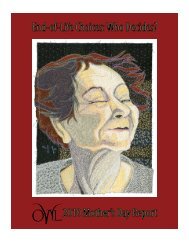elder abuse: a women's issue - OWL-National Older Women's League
elder abuse: a women's issue - OWL-National Older Women's League
elder abuse: a women's issue - OWL-National Older Women's League
Create successful ePaper yourself
Turn your PDF publications into a flip-book with our unique Google optimized e-Paper software.
Elder Abuse: A Women’s IssueLisa Nerenberg, MSW, MPHSince <strong>elder</strong> <strong>abuse</strong> first emerged into the public’sconsciousness in the late 1970s, it has been describedas a caregiving <strong>issue</strong>, domestic violence, a hate crime,a victims’ rights <strong>issue</strong>, a syndrome, and a public healthconcern. Somewhat surprisingly, in light of the fact thatit disproportionately affects women, there has been littleattention to the unique circumstances, vulnerabilities,and needs of <strong>abuse</strong>d <strong>elder</strong>ly women. <strong>OWL</strong>’s focus on<strong>elder</strong> <strong>abuse</strong> for its 2009 Mothers Day Report providesa long overdue occasion to consider these factors and toexplore the emerging global perspective on <strong>elder</strong> <strong>abuse</strong>as a women’s <strong>issue</strong>.Women as Victims of Elder AbuseStudies that examine cases of <strong>abuse</strong> and neglect thatare reported to agencies, health care providers, and lawenforcement consistently show that the majority ofvictims are women (<strong>National</strong> Research Council, 2003).This appears to be true for all forms of <strong>elder</strong> <strong>abuse</strong>except abandonment, and the ratio of female to malevictims varies significantly depending on the type of<strong>abuse</strong> (<strong>National</strong> Center on Elder Abuse, 1998).In recent years, the field of <strong>elder</strong> <strong>abuse</strong> prevention hasattempted to achieve a clearer understanding of victims’experiences and needs, particularly when victims declinehelp. Perhaps nowhere is this emphasis more apparentthan in the field’s response to domestic violence.Researchers, practitioners, and advocates have cometo recognize that domestic violence continues into oldage and may get worse as a result of age-related factorslike retirement and the role reversals that result fromlife-style changes or physical decline. Violence may alsobegin in old age, although “late onset” violence oftenstems from dementias and is generally not considered tobe domestic violence if the power and control motive,a defining feature of domestic violence, is not present.Elders may also enter into violent relationships inadvanced age.The field of <strong>elder</strong> <strong>abuse</strong> prevention has drawnheavily upon the wisdom and experiences of thedomestic violence movement in adapting services and" Somewhat surprisingly, in light of thefact that it disproportionately affectswomen, there has been little attention tothe unique circumstances, vulnerabilities,and needs of <strong>abuse</strong>d <strong>elder</strong>ly women. "interventions for older women. Advocates for youngervictims have long understood that domestic violenceis rooted in society’s acceptance of men’s right todominate their intimate partners through violence andthreats. They further recognize that these attitudes aresupported and reinforced by institutions, including thejustice system. Historically, acts of violence that wereconsidered to be crimes when the victims were strangerswere treated as “family matters” when victims wereintimate partners. Women were justifiably distrustfulof the system; the vast majority of domestic violencevictims still do not report their injuries, and most ofthose who do later minimize the <strong>abuse</strong> or recant theirstories. Interventions to overcome these barriers focuson empowering women through consciousness raisingand creating support groups, as well as ensuring theirsafety through restraining orders, shelters, and safetyplanning.Domestic violence advocates have also long recognizedthe social and economic hurdles that victims face. Formany women, leaving abusive partners results in poverty,and strong social pressures to tolerate <strong>abuse</strong> discourageothers from leaving or accepting help. The domesticviolence movement has increasingly acknowledged thatgender-based inequalities and discrimination are not theonly barriers that women face: race, class, age, religion,and sexual orientation also play a role. Recognizingthat these “macro” problems call for macro solutions,advocates have focused on changing attitudes aboutviolence against women, enacting laws to criminalizedomestic violence, and promoting economic selfsufficiencyfor women.Although there have been few studies exploring theimpact of domestic violence on <strong>elder</strong>ly women, practiceexperience and anecdotal evidence suggest that olderwomen encounter many of the same barriers as youngerwomen and additional ones. Violence against older14



